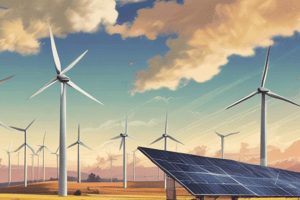Podcast
Questions and Answers
What is the approximate rate at which solar energy arrives at the earth’s atmosphere?
What is the approximate rate at which solar energy arrives at the earth’s atmosphere?
- 1000 W/m2
- 1353 W/m2 (correct)
- 2000 W/m2
- 1500 W/m2
What is the equivalent solar irradiance in Btu/hr ft2 based on the given rate?
What is the equivalent solar irradiance in Btu/hr ft2 based on the given rate?
- 300 Btu/hr ft2
- 850 Btu/hr ft2
- 600 Btu/hr ft2
- 428 Btu/hr ft2 (correct)
Which of the following statements is true regarding solar irradiance?
Which of the following statements is true regarding solar irradiance?
- It is primarily affected by temperature.
- It varies depending on geographical location. (correct)
- It is measured in Joules per cubic meter.
- It is constant throughout the day.
In solar irradiance measurements, what unit is used to express power per unit area?
In solar irradiance measurements, what unit is used to express power per unit area?
If solar energy arrives at a rate of 1353 W/m2, how much energy is that in terms of energy per hour for one square meter?
If solar energy arrives at a rate of 1353 W/m2, how much energy is that in terms of energy per hour for one square meter?
What is the full name of the individual mentioned in the content?
What is the full name of the individual mentioned in the content?
What is the numerical code associated with Essam Abou Yehia?
What is the numerical code associated with Essam Abou Yehia?
Which of the following best describes Essam Abou Yehia's title?
Which of the following best describes Essam Abou Yehia's title?
Which of the following statements is accurate regarding the format presented?
Which of the following statements is accurate regarding the format presented?
What can be inferred about the purpose of this content?
What can be inferred about the purpose of this content?
What is one possible use of removing moisture from a material?
What is one possible use of removing moisture from a material?
Which of the following scenarios might require operating a cooling device?
Which of the following scenarios might require operating a cooling device?
What could be a consequence of excessive space heat?
What could be a consequence of excessive space heat?
What is the primary function of a cooling device?
What is the primary function of a cooling device?
Why is it important to control moisture levels in materials?
Why is it important to control moisture levels in materials?
What is one application of solar thermal systems?
What is one application of solar thermal systems?
Which system utilizes solar energy to produce electricity directly?
Which system utilizes solar energy to produce electricity directly?
What is a key advantage of wind power?
What is a key advantage of wind power?
Which statement is true regarding photovoltaic systems?
Which statement is true regarding photovoltaic systems?
What is the primary energy source for wind power?
What is the primary energy source for wind power?
What is the primary function of evacuated tubes in solar applications?
What is the primary function of evacuated tubes in solar applications?
How does the design of evacuated tubes help prevent heat loss?
How does the design of evacuated tubes help prevent heat loss?
In what way is the concept of evacuated tubes similar to flat plate collectors?
In what way is the concept of evacuated tubes similar to flat plate collectors?
What does the term 'vacuum' refer to in the context of evacuated tubes?
What does the term 'vacuum' refer to in the context of evacuated tubes?
What is a significant benefit of using evacuated tubes over other solar heating methods?
What is a significant benefit of using evacuated tubes over other solar heating methods?
What type of wind turbines are predominantly in use today?
What type of wind turbines are predominantly in use today?
Which statement accurately describes the characteristic of the majority of modern wind turbines?
Which statement accurately describes the characteristic of the majority of modern wind turbines?
What is a key feature of horizontal-axis wind turbines compared to other types?
What is a key feature of horizontal-axis wind turbines compared to other types?
Which of the following is NOT a benefit associated with horizontal-axis wind turbines?
Which of the following is NOT a benefit associated with horizontal-axis wind turbines?
What mainly determines the type of wind turbines utilized in current applications?
What mainly determines the type of wind turbines utilized in current applications?
Flashcards
Solar Thermal Systems
Solar Thermal Systems
Systems that use the sun's heat to create energy.
Photovoltaic Systems
Photovoltaic Systems
Systems that convert sunlight directly into electricity.
Wind Power
Wind Power
Energy generated using the wind's kinetic energy.
Alternative Energy
Alternative Energy
Signup and view all the flashcards
Energy Systems
Energy Systems
Signup and view all the flashcards
Solar Irradiance
Solar Irradiance
Signup and view all the flashcards
Solar Energy Rate
Solar Energy Rate
Signup and view all the flashcards
1353 W/m2
1353 W/m2
Signup and view all the flashcards
428 Btu/hr ft2
428 Btu/hr ft2
Signup and view all the flashcards
Solar Energy on Earth
Solar Energy on Earth
Signup and view all the flashcards
Space Heat
Space Heat
Signup and view all the flashcards
Moisture Removal
Moisture Removal
Signup and view all the flashcards
What does "removing moisture" mean?
What does "removing moisture" mean?
Signup and view all the flashcards
Horizontal-axis turbine
Horizontal-axis turbine
Signup and view all the flashcards
Wind turbine
Wind turbine
Signup and view all the flashcards
What type of wind turbines are most common?
What type of wind turbines are most common?
Signup and view all the flashcards
Rotor
Rotor
Signup and view all the flashcards
Vertical axis
Vertical axis
Signup and view all the flashcards
Evacuated Tubes
Evacuated Tubes
Signup and view all the flashcards
Flat Plate (Solar Collector)
Flat Plate (Solar Collector)
Signup and view all the flashcards
Solar Radiation
Solar Radiation
Signup and view all the flashcards
Heat Convection
Heat Convection
Signup and view all the flashcards
Vacuum's Role
Vacuum's Role
Signup and view all the flashcards
Study Notes
Energy Management 1 AU 2nd Term Spring 2024
- Chapter 9 is about alternative energy sources
- Alternative energy sources are non-depleting or renewable
- Examples include solar, wind, and others that replace traditional fossil fuels
- Government funding and tax incentives for alternative energy reduced in the 1980s and 1990s
- The MENA region receives high solar irradiance globally
Solar Thermal Systems
- Introduction to the topic
- Solar Irradiance details
- Solar Thermal Collectors
- Thermal Storage Systems
- Surface temperature (Tsurface) = 5778 K (5505°C)
- Core temperature (Tcore) = 15.6 × 10⁶ K
- Power = 3.85 × 10²⁶ Watts
- Energy = 3.37 × 10²⁷ KW⋅hr/yr
- Annual Energy Intercepted on Earth: 1.5 × 10¹⁸ KW⋅hr/year (0.000000045%)
- World Energy Demand: 1.4 × 10¹⁴ KW⋅hr/yr (0.0093%) - Total: 4.2 × 10⁻¹² %
Solar Irradiance (Distribution)
- The MENA region receives the highest solar irradiance globally
Solar Irradiance (Orientation)
- Designers should estimate the solar radiation angle to remain perpendicular to it for maximum energy collection
Solar Thermal Collectors (Non-Concentrating)
- Flat plate collectors
- Evacuated tube collectors
- Volumetric air collectors
- The flat-plate collector typically faces south in the Northern Hemisphere
- These collectors bring the temperature of a liquid or air up from ambient conditions
- Tracking-type collectors used when high temperatures (over 120°C) are required
Solar Thermal Collectors (Concentrating)
- Parabolic Trough collectors
- CSP collectors
- Fresnel collectors
- Solar Power Tower
- Solar Dish Sterling Engine
Solar Irradiance (Numerical Facts)
- Solar energy arrives at the Earth's atmosphere at a rate of approximately 1353 W/m² (428 Btu/hr ft²)
- This value is the solar constant
- Part of this is reflected, absorbed and scattered in the atmosphere
- When at 40° North Latitude, the noontime radiation rate on a flat surface normal to the sun's rays around 946 W/m² (300 Btu/hr ft²) on a clear day
- A solar collector should track the sun to remain normal to the incoming rays at all times
- A perfect collector may only capture 70% of the energy
- The realistic area to generate 293 kWh(16 million Btu) of energy per day is around 53 m²(567 ft²)
Volumetric Air Collector
- An alternative to liquid solar systems
- Freezing is not a concern with volumetric air collectors
- Leaks are less detrimental than with liquid systems
- Corrosion is less likely to occur
Parabolic Trough
- Temperature range: 250-450°C
- Concentrating collectors for high temperatures (like power generation)
- Cannot use diffuse or scattered radiation, must track the direct sun
Compound Parabolic Concentrator (CPC)
- Used in residential and commercial heating applications
Fresnel
- Composed of multiple smaller flat mirrors to concentrate radiation like parabolic troughs, but simpler and cheaper
Solar Power Tower
- Uses a set of two-axis tracking mirrors (heliostats) to reflect sunlight to a central tower
- Uses molten salt (Sodium Nitrate NaNO₃) as a coolant
Thermal Storage Systems
- Energy demand isn't always tied to solar availability, so storage is needed
- Water is the most common storage, often in tanks, but water freezes and therefore antifreeze may be required.
- Rock-bed storage is used with air-type collectors.
Solar Cells (Photovoltaics)
- The electronic properties of a semiconductor converts sunlight to electricity
- Most solar cells are p-n junction diodes (composed of p-type and n-type materials)
- p-n junctions have electronic asymmetry
- N-type regions have high electron densities and low hole densities. Electrons move easily; holes move with difficulty
- P-type materials are the opposite
- Excess electron-hole pairs are generated when illuminated
- Electrons move from p-type to n-type, and holes move in the opposite direction
Studying That Suits You
Use AI to generate personalized quizzes and flashcards to suit your learning preferences.





